Extinct Mammal Groups
|
Eutriconodonts (or simply triconodonts) were an early group of mammals that were common and diverse mammals during the Mesozoic Era. They did not survive the K-Pg extinction. They had a variety of lifestyles similar to those of modern small mammals
Insectivorous forms, such as this Jeholodens jenkinsi, were common. You can see that the ribs do not extend all the way back to the pelvis, indicating the presence of a diaphragm muscle for breathing.
China
Early Cretaceous Period, 130-125 Ma
Fernbank Museum of Natural History, Georgia
|
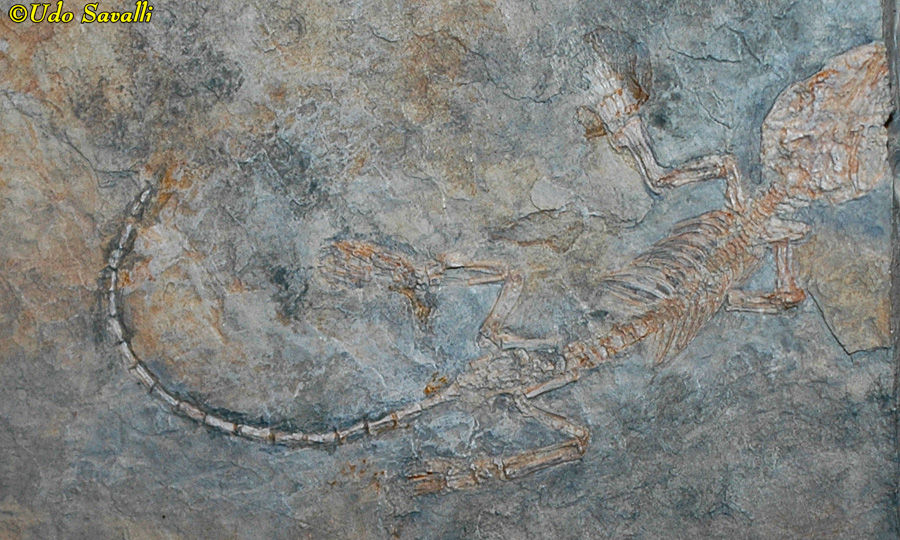
|
|
|
The Cimolesta were a later group of mammals that first appeared in the late Cretaceous and survived into the Oligocene Epoch. They were probably cousins to the Eutherian mammals (below).
Palaeosinopa sp. was an otter-like mammal: its large feet suggest that it was a good swimmer.
Green River Formation, Wyoming
Early Eocene Epoch, 50 Ma
Wyoming Dinosaur Center
|

|
|
Metatheria — The Marsupials
|
Marsupials (Subclass Metatheria) are the pouched mammals such as opossums and kangaroos. Although modern marsupials are mostly restricted to South and Central America and the Australian regions, their fossils are more widely distributed.
Didelphodon vorax was a carnivore with a powerful bite.
Order Didelphimorphia?
Hell Creek Formation, Harding Co., South Dakota
Late Cretaceous Period, 66 Ma
Dinosaur Resource Center, Colorado
|
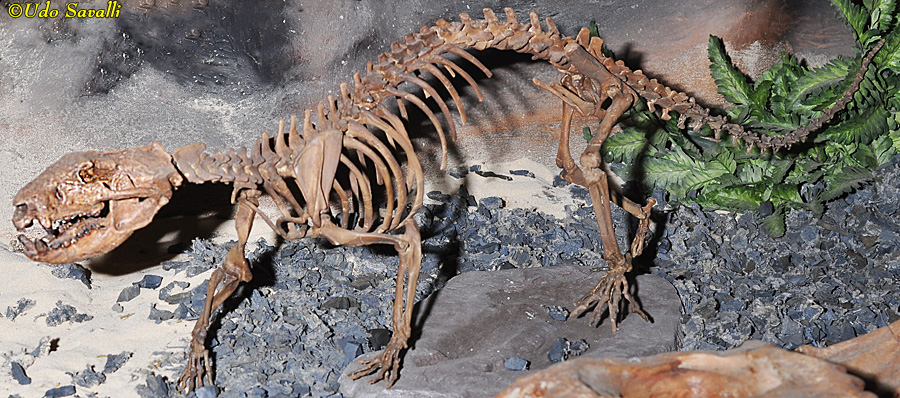
|
|
|
The saber-toothed marsupial, Thylacosmilus sp., evolved extremely long canine teeth convergently to several groups of eutherian carnivores.
Order Sparassodonta (extinct)
Argentina
Miocene Epoch, 15 Ma
International Wildlife Museum, Tucson
|
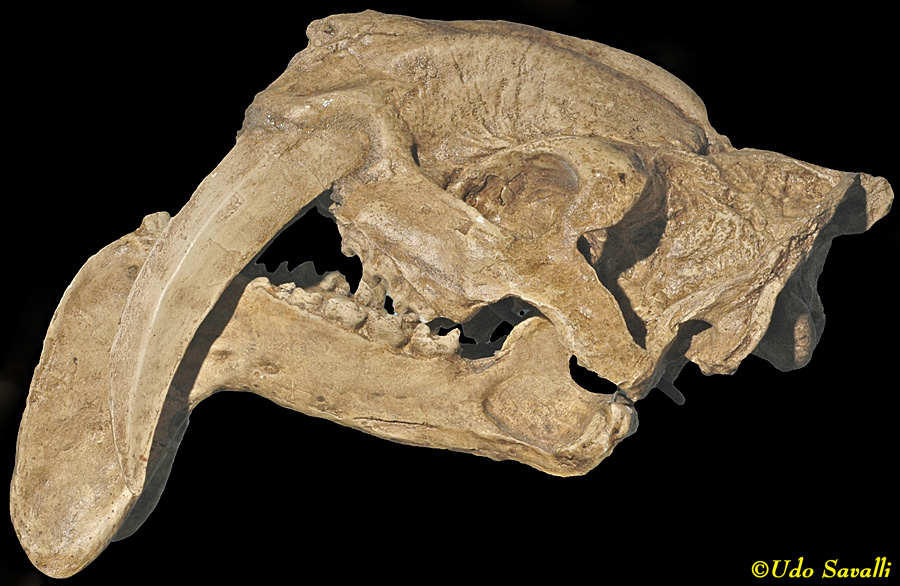
|
|
Eutheria — The Placental Mammals
|
Eutherian mammals have a more complex placenta that allows young to be carried in whe womb for much longer than in marusupials. There are also various anatomical differences in the skull and other parts of the skeleton.
American Mastodon, Mammut americanum.
Order Proboscidia (elephants & relatives)
Boney Springs, Benton Co., Missouri
Pleistocene Epoch, 17-13 ka
Arizona Museum of Natural History
|
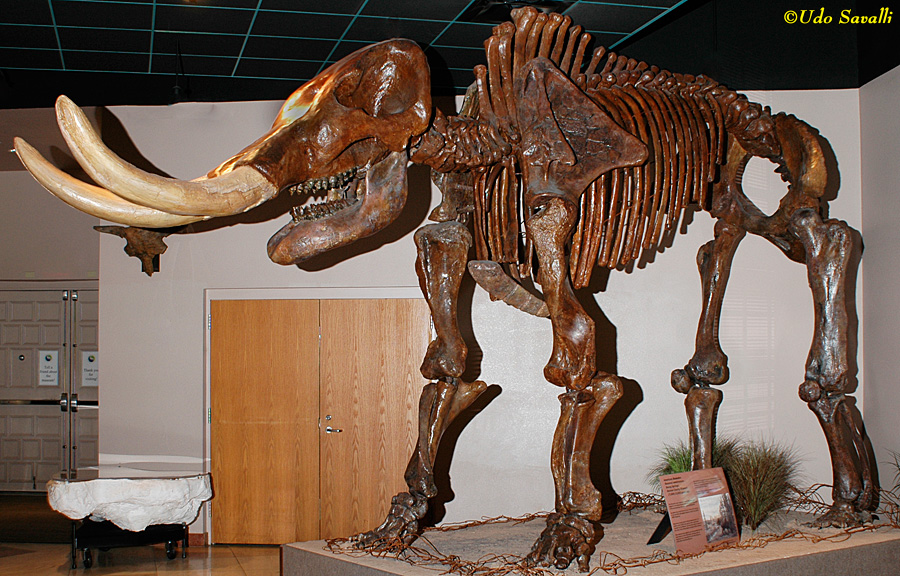
|
|
|
Columbian Mammoth, Mammuthus columbi, at dig site (skull and tusk at left).
Order Proboscidia
Hot Springs, South Dakota
Pleistocene Epoch, 20 ka
in situ at Mammoth Site
|
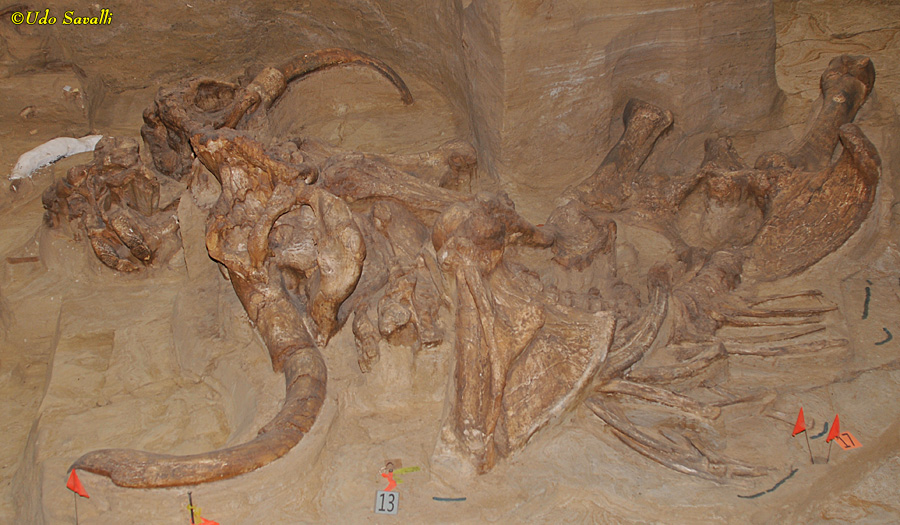
|
|
|
Columbian Mammoth, Mammuthus columbi.
Order Proboscidia
La Brea Tar Pits, California
Pleistocene Epoch
Page Museum, Los Angeles, California
|
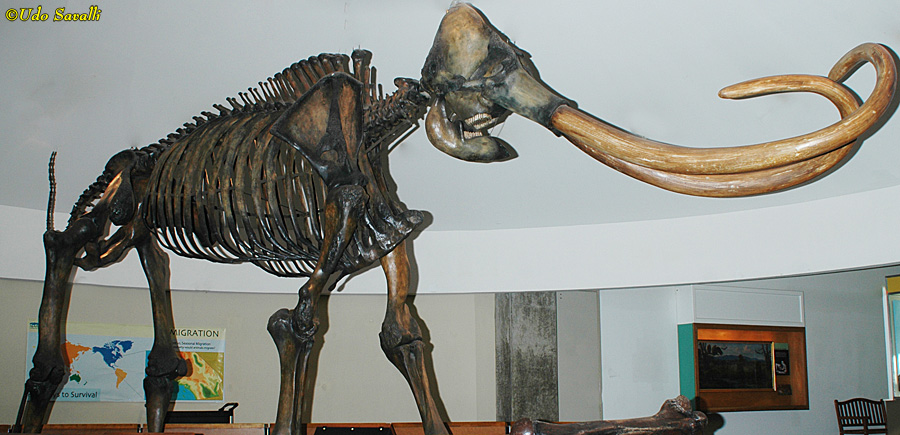
|
|
|
Gomphotherium phippsi skeleton (80% real).
Order Proboscidia
Valentine Formation, Brown Co., NE
Middle Miocene Epoch, 13 Ma
Denver Museum of Science & Nature
|
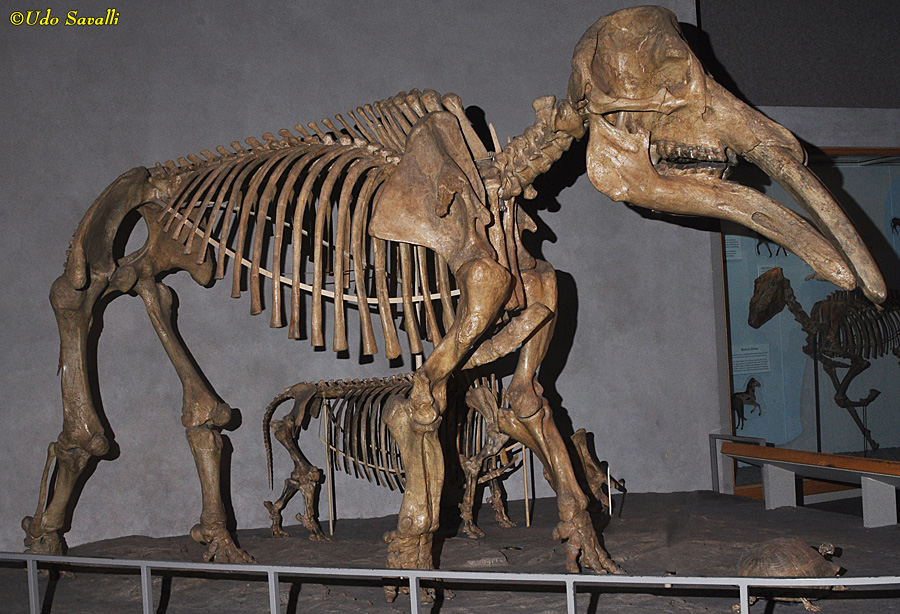
|
|
|
Cast replica of a frozen baby Woolly Mammoth, Mammuthus primigenius, mummy.
Order Proboscidia
Siberia
40,000 years ago
Mammoth Site, South Dakota
|
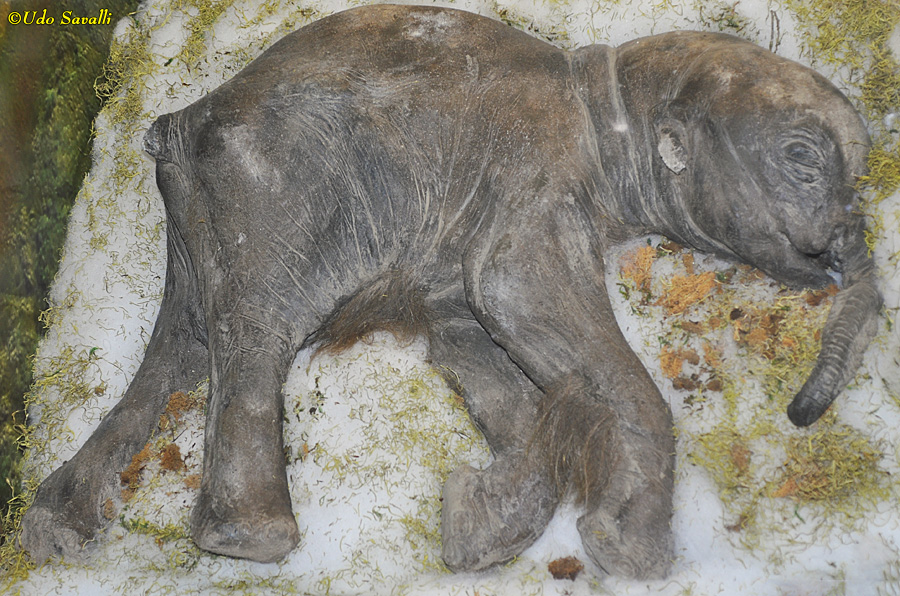
|
|
|
Sirenians are fully aquatic marine mammals that evolved their aquatic lifestyle independently of the cetaceans (whales). Sirenians are herbivorous.
Jordan's Sea Cow, Dusisiren jordani, is a typical example.
Order Sirenia (dugongs & manatees)
Santa Cruz, Calif.
Late Meiocene Epoch, 13.6-10.3 Ma
Los Angeles Museum of Natural History
|
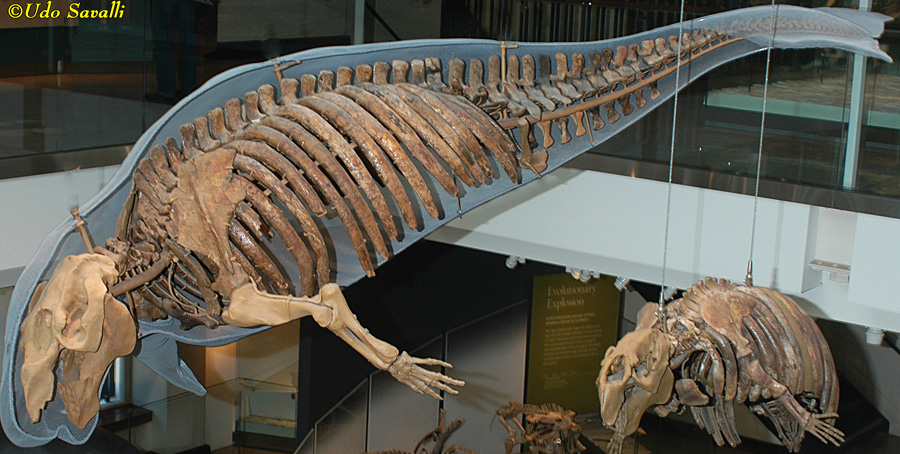
|
|
|
Metaxytherium floridanum dugong skeleton cast.
Order Sirenia
Florida
Miocene Epoch
Black Hills Institute Museum, South Dakota
|
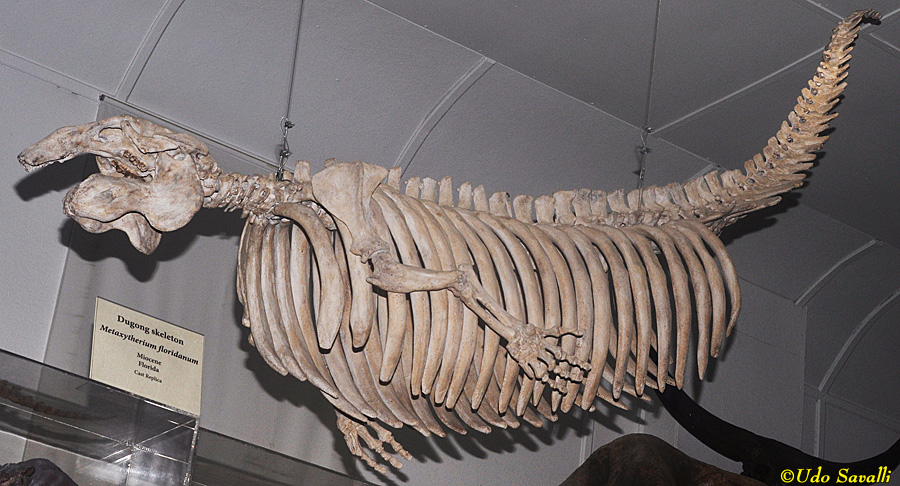
|
|
|
Pezosiren portelli is an ancestral semi-aquatic sirenian.
Order Sirenia
Jamaica
Eocene Epoch
Black Hills Institute Museum, South Dakota
|

|
|
|
Desmostylians, such as this Neoparadoxia cecilialina, are an obscure group of aquatic mammals; they were probably herbivorous with a unique type of suction feeding. Their relationships to other mammals have been long debated, with links to sirenians, elephants, and horses/rhinos all being suggested.
Order Desmostylia (extinct)
Aliso Viejo, Calif.
Late Meiocene, 12-10 Ma
Los Angeles Museum of Natural History
|

|
|
|
Ground sloths, such as this Harlan's Ground Sloth, Paramylodon harlani, were giant terrestrial relatives of the small modern tree-climbing species.
Order Xenarthra (sloths, armadillos, & anteaters)
Rancho La Brea, CA
Late Pleistocene, 40-11 ka
Los Angeles Museum of Natural History
|
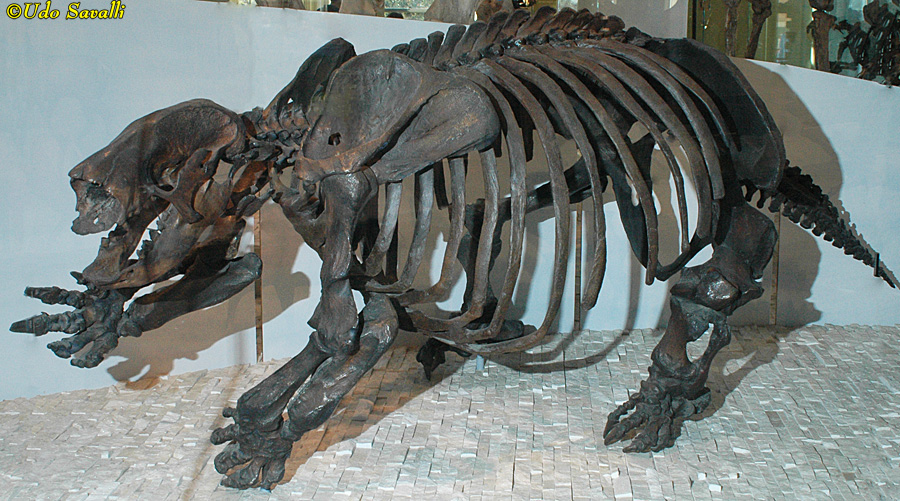
|
|
|
Shasta Ground Sloth, Nothrotheriops shastensis.
Order Xenarthra
Nuevo Leon, Mexico
Late Pleistocene, 40-27 kya
Los Angeles Museum of Natural History
|
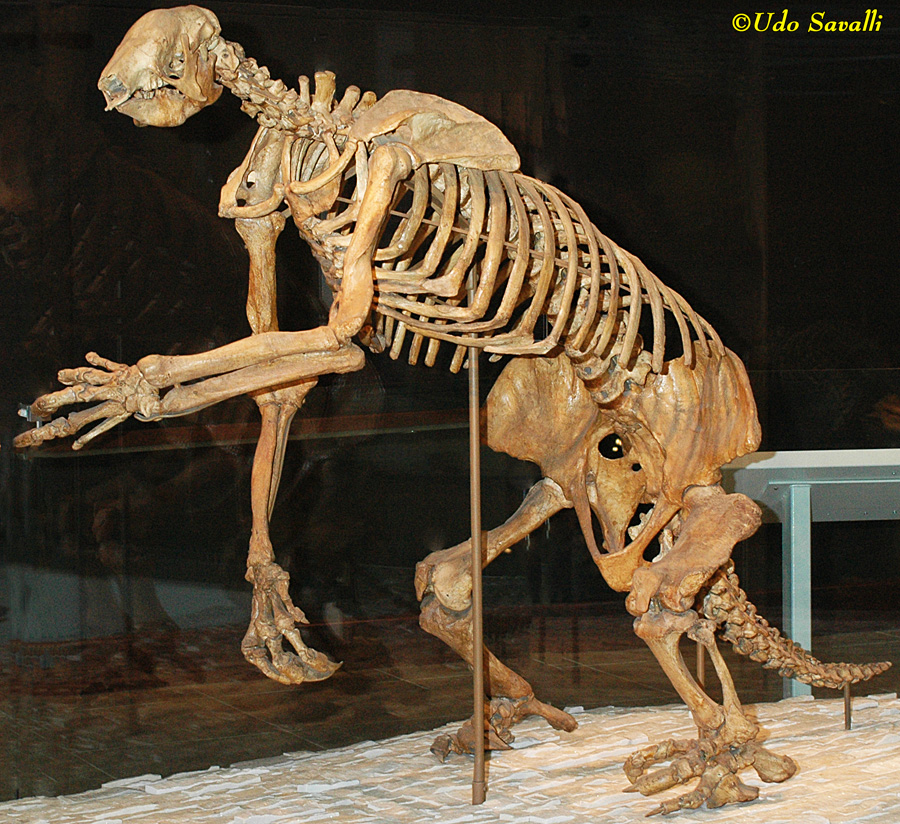
|
|
|
Megalonyx jeffersoni, a medium-sized ground sloth at about 3 m long.
Order Xenarthra
North & Central America
10 - 0.11 Ma
Dinosaur Resource Center, Colorado
|
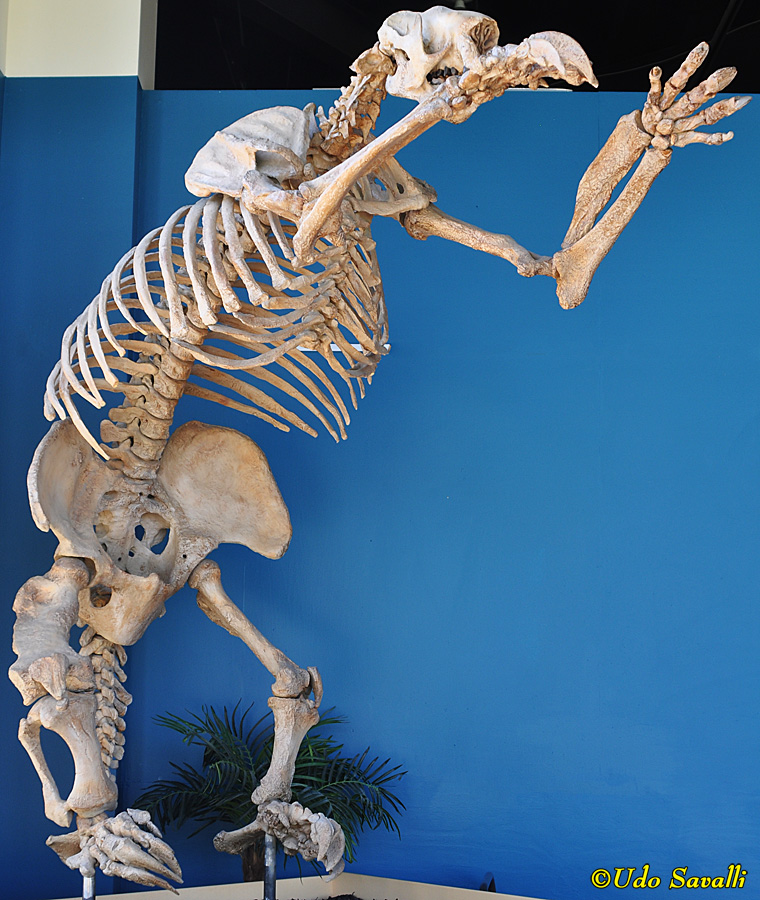
|
|
|
Eremotherium laurillardi ground sloth.
Order Xenarthra
Florida
Late Pleistocene, 120 ka
Museum of Ancient Life, Utah
|
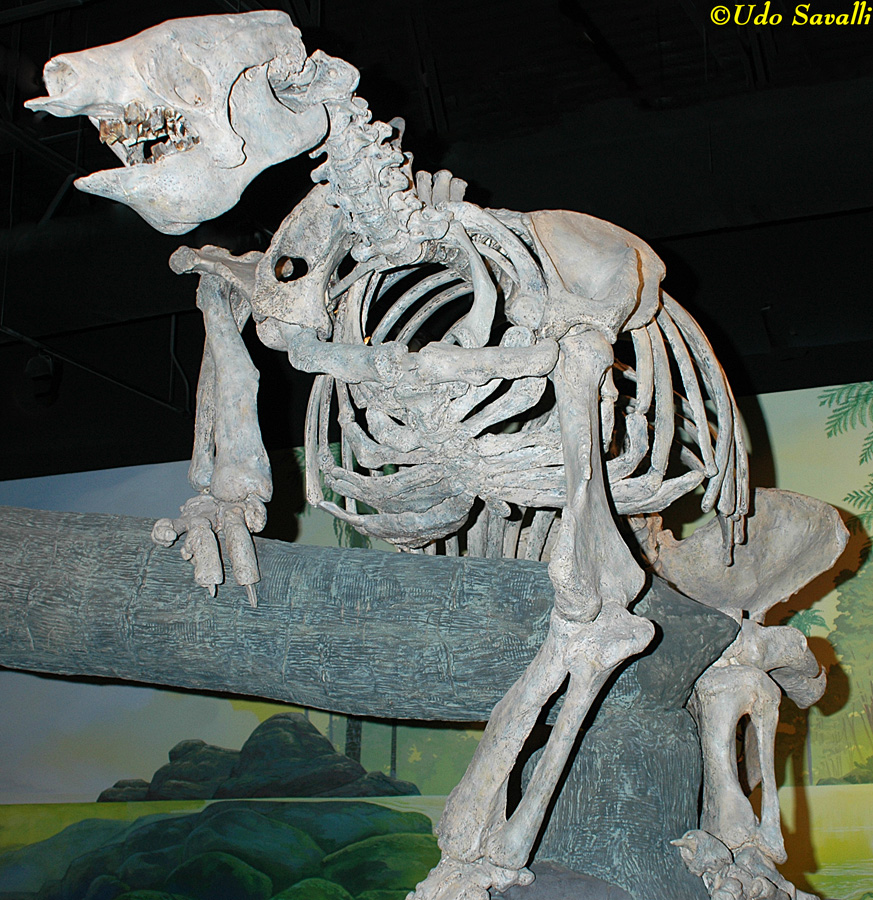
|
|
|
Glyptodons were giant relatives of the modern armadillos, and like them, had dermal (skin-based) armor that formed a shell-like carapace. This is the armored carapace of Glyptotherium texanum.
Order Xenarthra
Graham Co., AZ
Pliocene, 2.4 Ma
Arizona Museum of Natural History
|
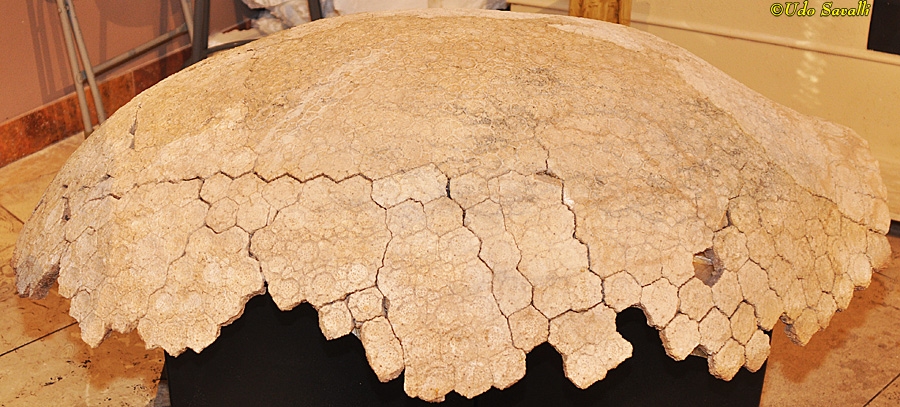
|
|
|
Panochthus tuberculatus glyptodont skeleton without the armor.
Order Xenarthra
South America
Pleistocene Epoch, 1 Ma
Museum of Ancient Life, Utah
|
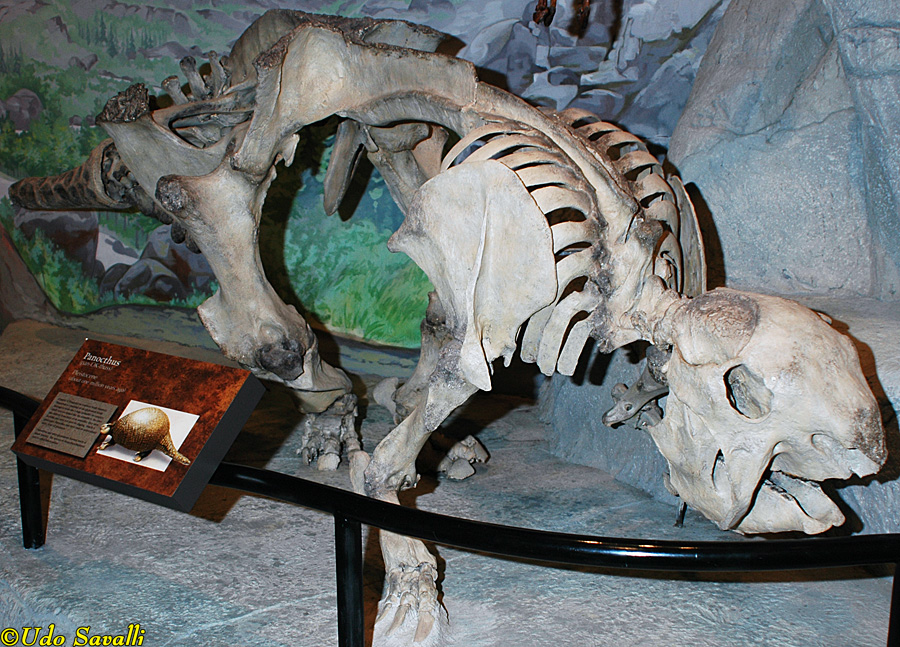
|
|
|
The rodents are the most successful group of modern mammals. They have a pair of upper and lower incisors that grow continuously, followed by a gap before the cheek teeth. Most are small sized, but the Giant Beaver, Castoroides ohioensis, was one of the largest.
Order Rodentia (rodents)
North America
Pleistocene, 1 Ma
Museum of Ancient Life, Utah
|
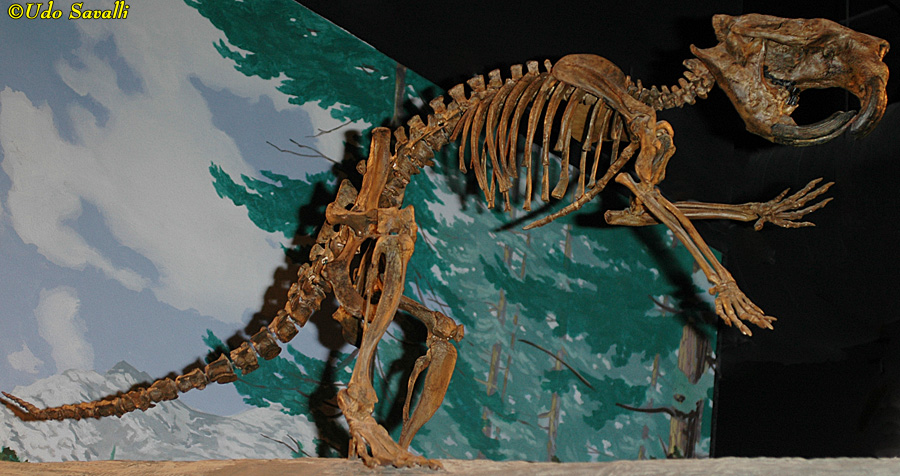
|
|
|
Palaeocastor sp. was an ancient beaver but lived more like modern prairie dogs.
Order Rodentia
Agate Springs, NE
Early Miocene, 22 Ma
Agate Fossil Beds National Monument
|
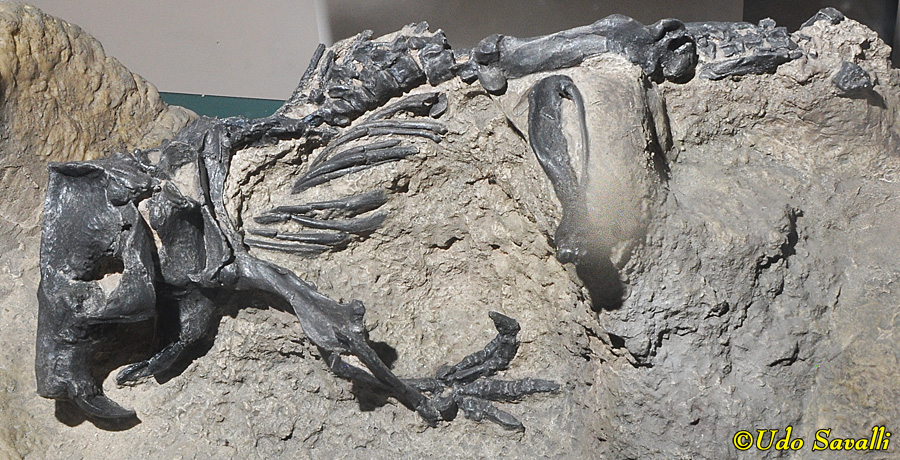
|
|
|
Paleocaster (fossil above) dug distinctive spiral burrows, nicknamed "devil's corkscrews".
Order Rodentia
Agate Springs, NE
Early Miocene, 22 Ma
Agate Fossil Beds National Monument
|
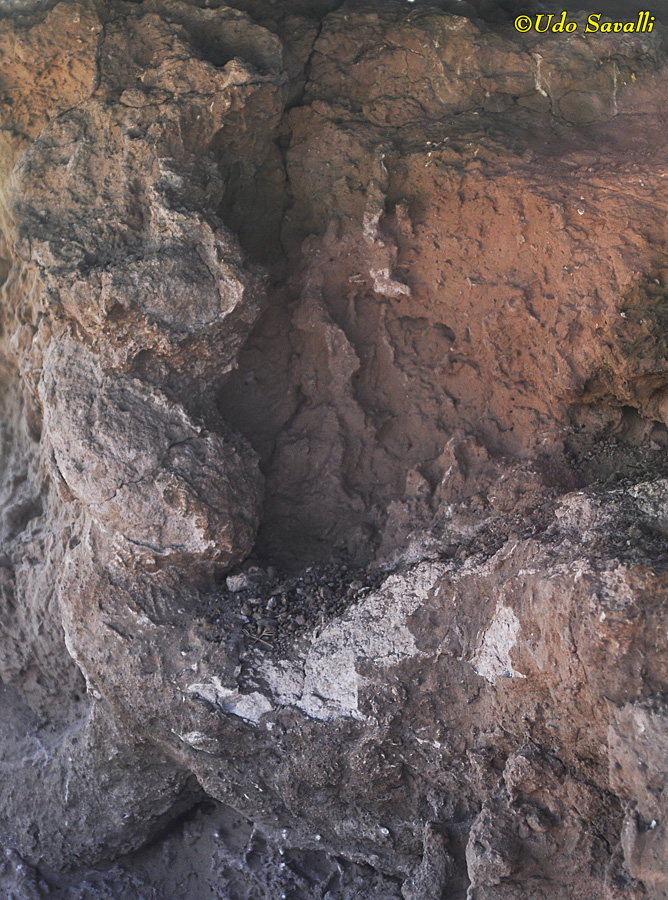
|
|
|
Lagomorphs are related to rodents, but differ in having short tails and in a number of skull characteristics. This is the skull and some bones of Paleolagus haydeni.
Order Lagomorpha (rabbits & pikas)
Middle Eocene
Black Hills Institute Museum, South Dakota
|
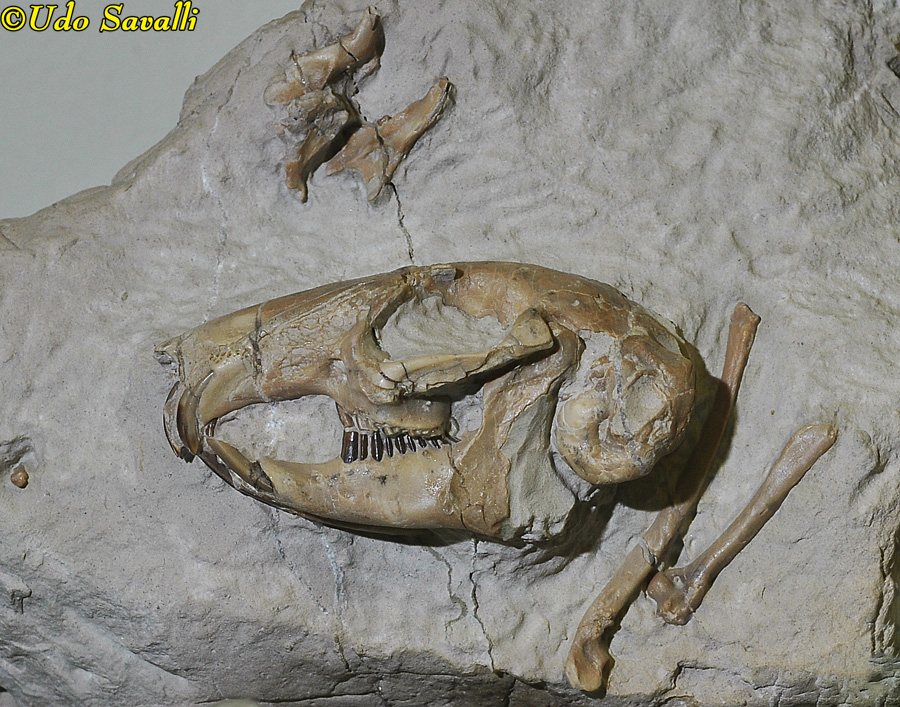
|
|
|
Smilodectes gracilis is a lemur-like primate that was transitional to the monkeys.
Order Primates
Bridger Formation, Sweetwater Co, WY
Middle Eocene, 49 Ma
Denver Museum of Science & Nature
|
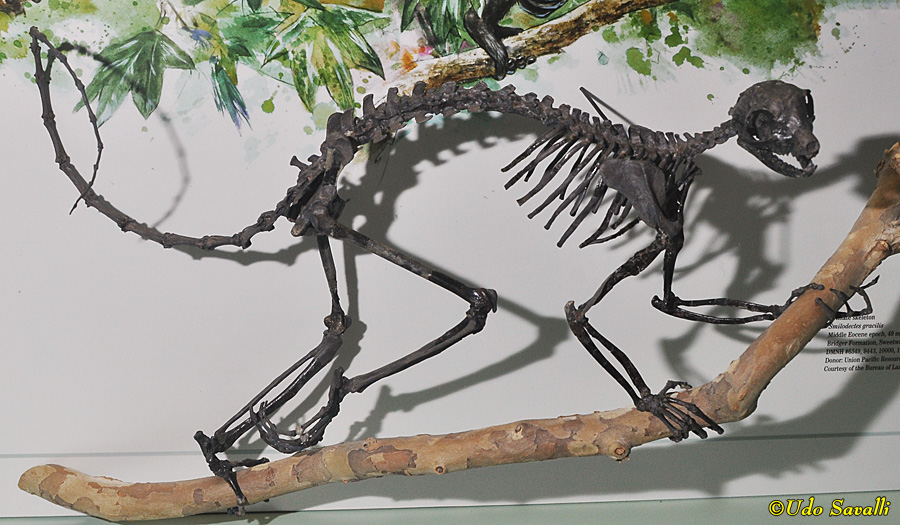
|
|
|
Notharctus tenebrosus is related to Smilodectes (above).
Order Primates
Bridger Formation, Wyoming
Eocene, 48 Ma
San Diego Natural History Museum
|
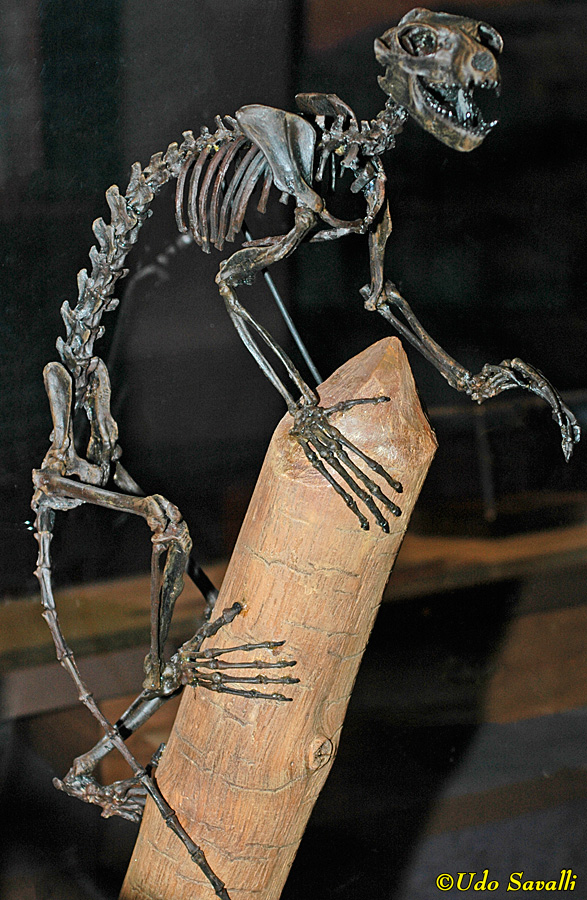
|
|
|
Australopithecus afarensis, cast of the "Lucy" skeleton.
Order Primates
Hadar, Ethiopia
Pleiocene, 3.2 Ma
Los Angeles Museum of Natural History
|
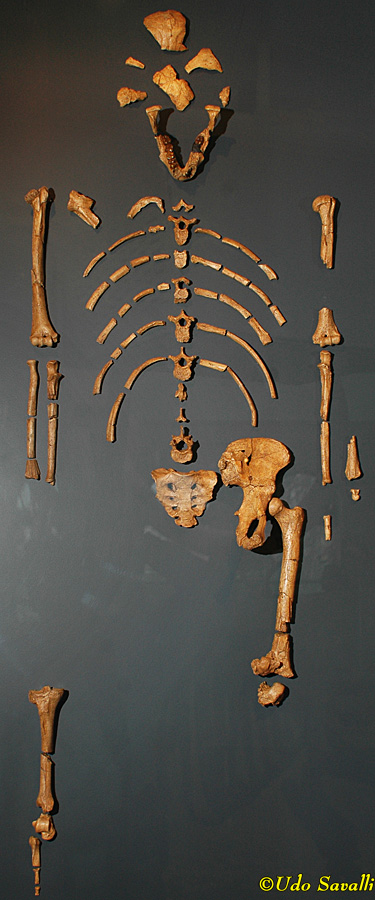
|
|
|
Homo ergaster, the earliest member of the genus Homo; cast of the "Turkana Boy" skeleton.
Order Primates
Nariokotome, Kenya
Pleistocene, 1.5 Ma
Los Angeles Museum of Natural History
|

|
|
|
Extinct hedgehog, Macrocranion tupaiodon.
Order Eulipotyphla (shrews, moles, & hedgehogs)
Messel Formation, Germany
Eocene, 49 Ma
San Diego Natural History Museum
|

|
|
|
Bats are the only mammals capable of powered flight. Unfortunately, even the oldest known bats, such as this Icaronycteris index, were fully capable of flight so we do not know how bats evolved.
Order Chiroptera (bats)
Green River Formation, Wyoming
Eocene, 52 Ma
Museum of Ancient Life, Utah
|
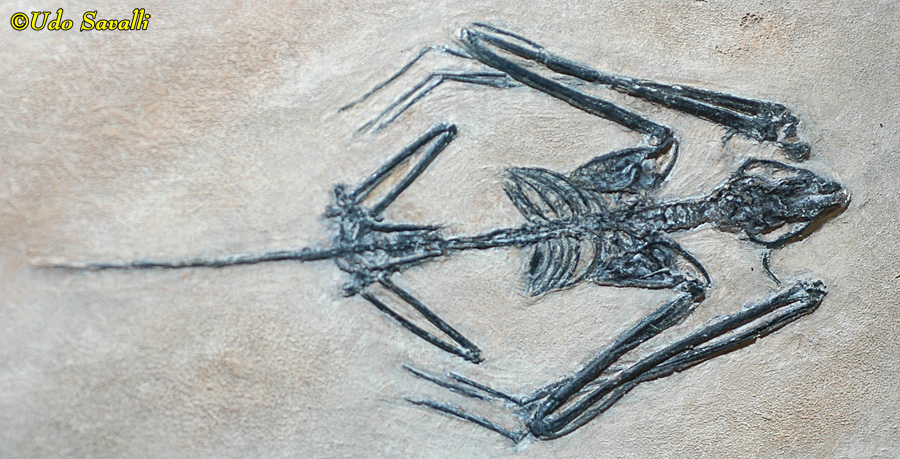
|
|
|
Paleochiropteryx tupainodon bat.
Order Chiroptera
Germany
Eocene, 47 Ma
Arizona Museum of Natural History
|
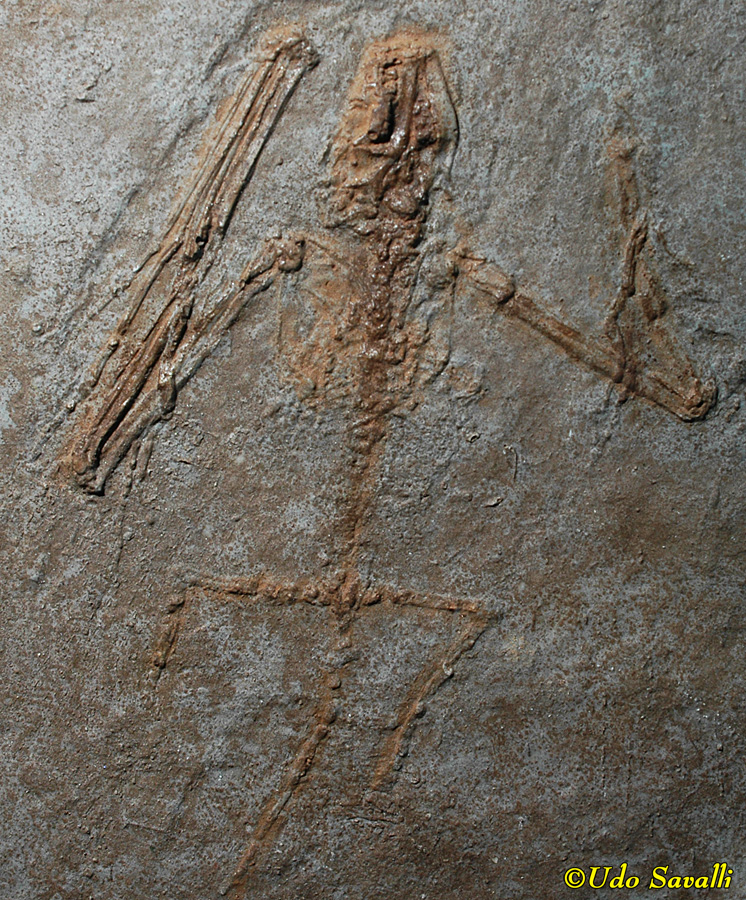
|
|
|
Creodonts are an extinct group of carnivorous mammals that may be related to modern Carnivora, but this relationship has been questioned.
The hyaenodonts, such as this Hyaenodon mustelinus, are a subgroup with thick bone-crushing teeth similar to those of modern hyaenas.
Order Creodonta (extinct)
North America
Oligocene, 35 Ma
Museum of Ancient Life, Utah
|
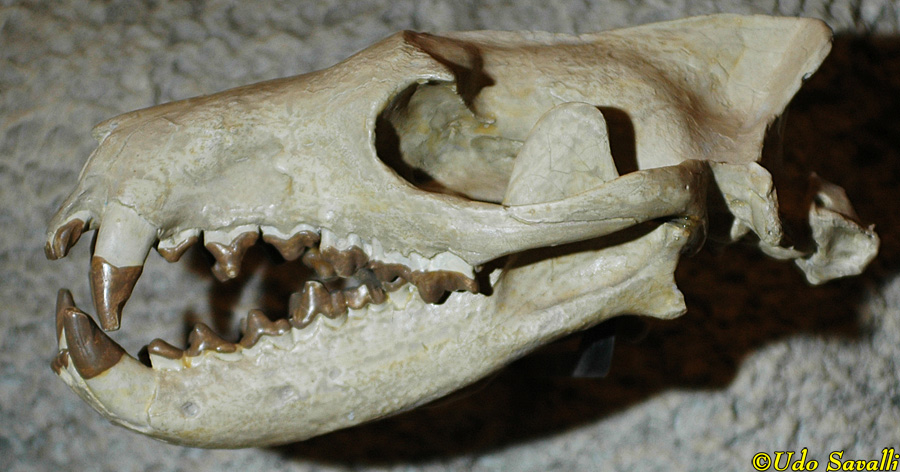
|
|
|
Hyaenodon horridus, skull of a juvenile..
Order Creodonta
Black Hills Institute Museum, South Dakota
|
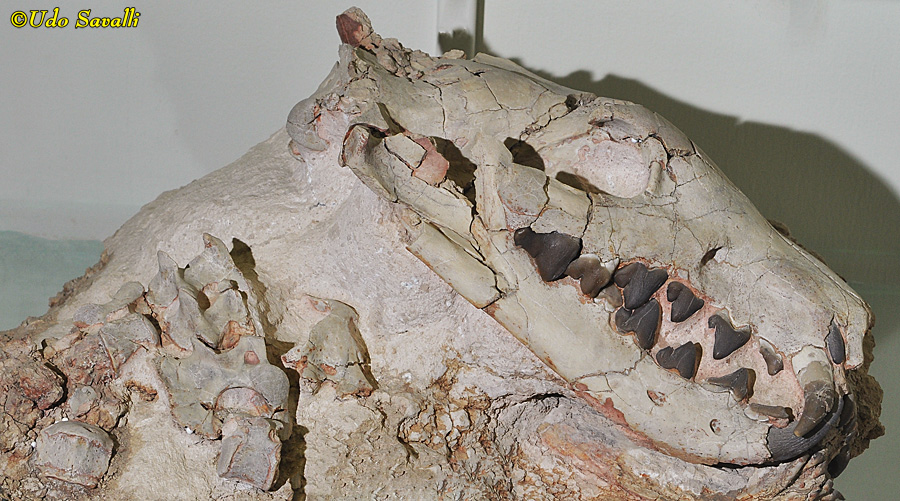
|
|
|
The hyaenodontid, Prototomus vulpeculus.
Order Creodonta
Denver Museum of Science & Nature
|
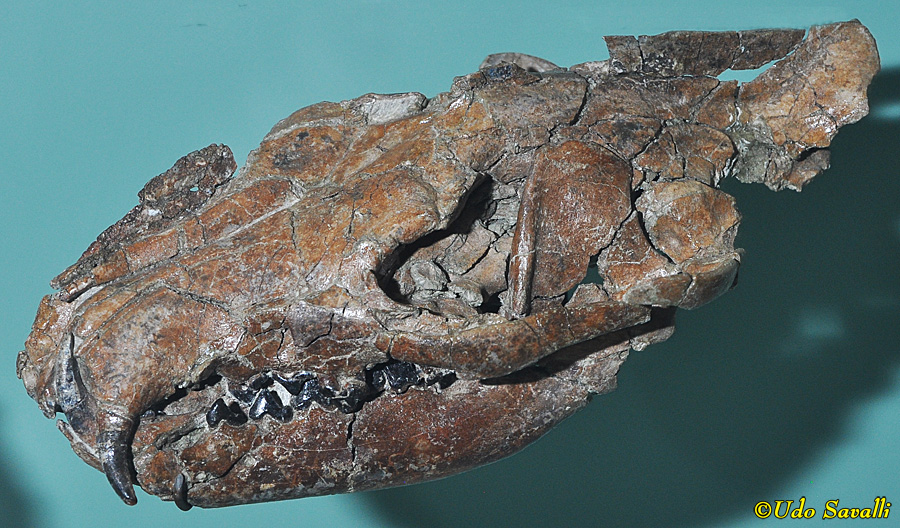
|
|
|
Dire wolves, Canis dirus, were slightly larger than today's gray wolves but had a proportionately larger head and a stronger bite. Recent research indicates that they were not true wolves but more related to South American dogs.
Order Carnivora (dogs, cats, bears, weasels, etc.)
La Brea Tar Pits, CA
Pleistocene
Page Museum, Los Angeles
|
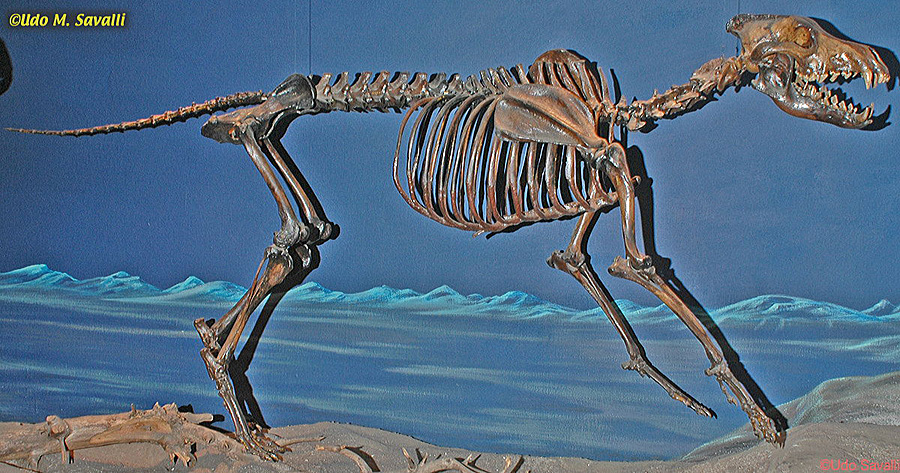
|
|
|
Epicyon haydeni was a large, powerful canid (dog family).
Order Carnivora
North America
Mid-late Miocene
Los Angeles Museum of Natural History
|
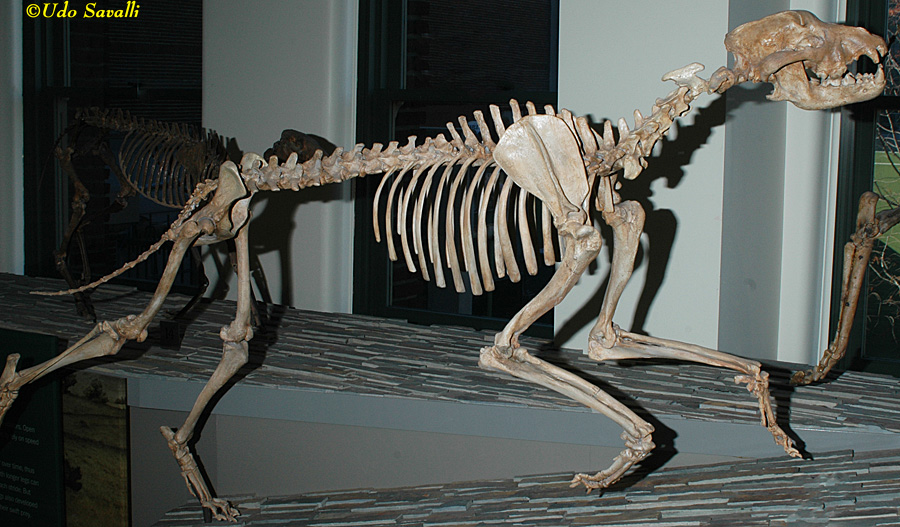
|
|
|
Hesperocyon gregarius was a canid (dog) that more closely resembled a racoon or civet.
Order Carnivora
Black Hills Institute Museum, South Dakota
|
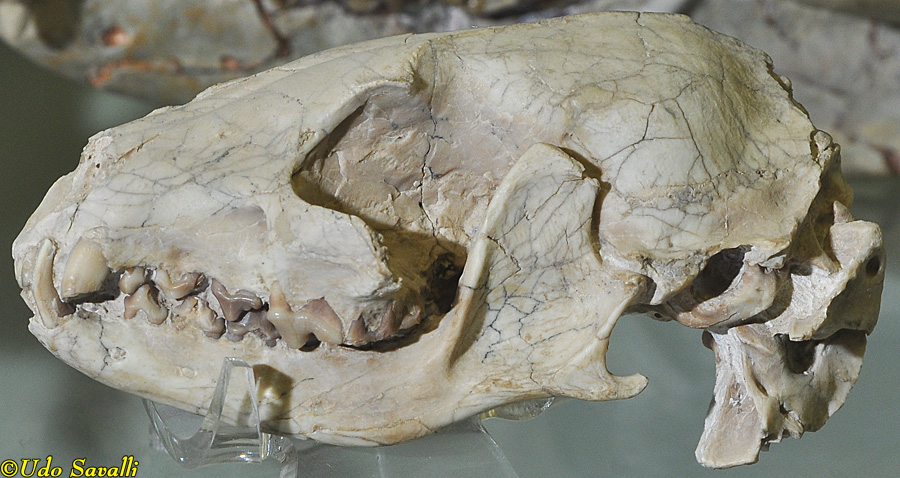
|
|
|
Short-faced Bear, Arctodus simus.
Order Carnivora
South Dakota
Pleistocene
Mammoth Site, South Dakota
|
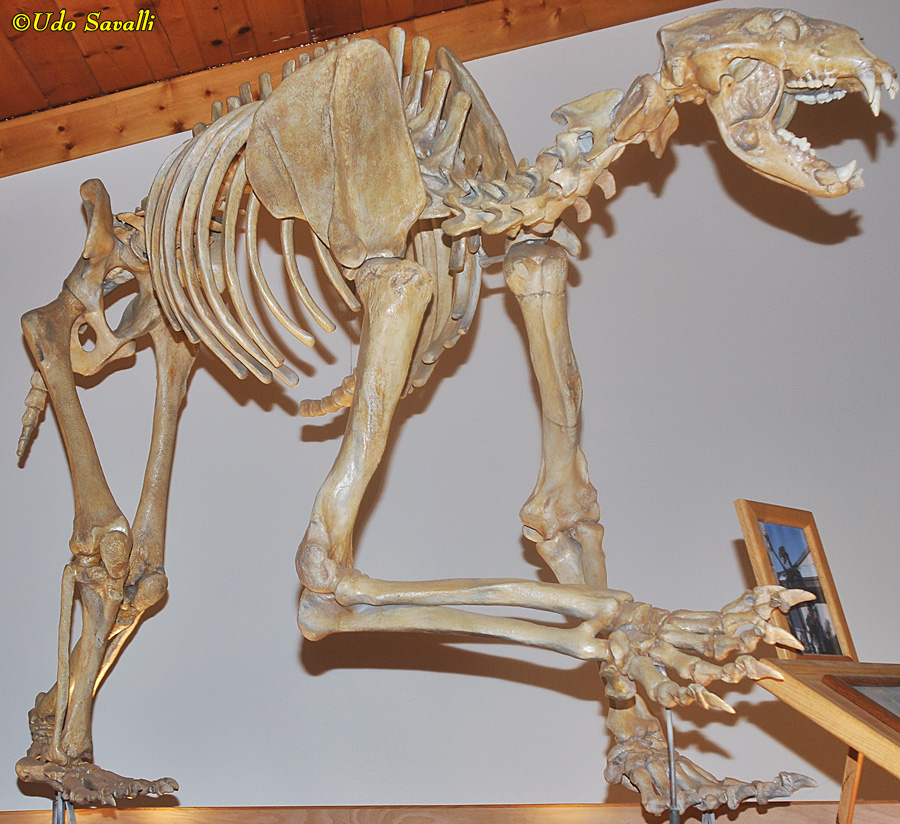
|
|
|
Cave Bear, Ursus spelaeus, skull.
Order Carnivora
Romania
Pleistocene
Black Hills Institute Museum, South Dakota
|
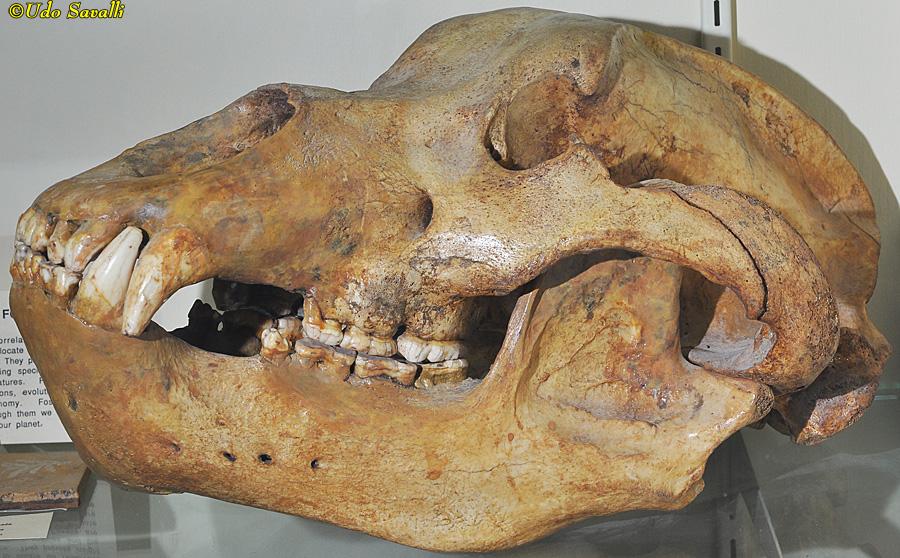
|
|
|
The beardog (extinct family Amphicyonidae), Daphoenodon superbus. The beardogs may have gone extinct due to competition from the later arriving true dogs.
Order Carnivora
Harrison Formation; Agate Springs, NE
Early Miocene, 21-19 Ma
Agate Fossil Beds National Monument
|
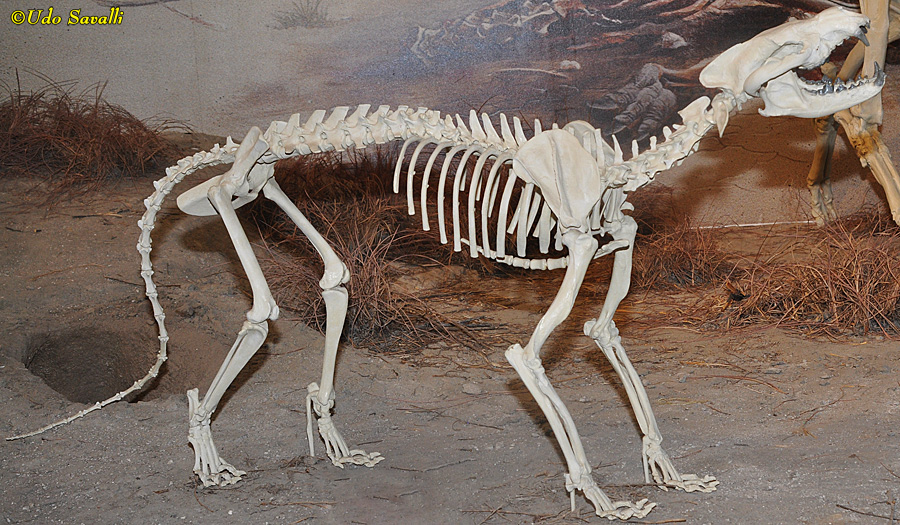
|
|
|
Naegele's Giant Jaguar, Panthera atrox, a member of the cat family (Felidae), has sometimes been called the American Lion, but this is less accurate as it is more closely related to the jaguar than the African lion.
Order Carnivora
La Brea Tar Pits, CA
Pleistocene
Page Museum, Los Angeles
|
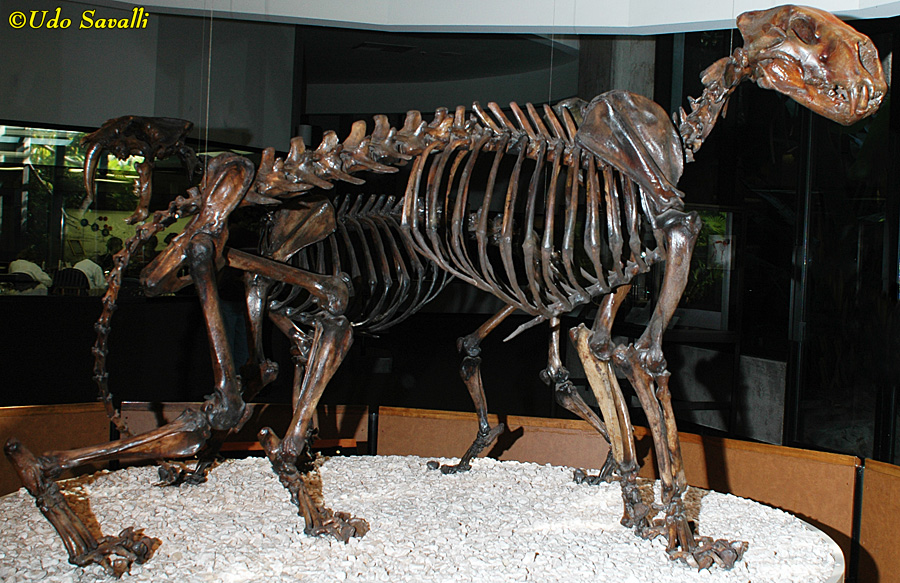
|
|
|
The sabertoothed cat (or less accurately, sabertoothed tiger), Smilodon californicus.
Order Carnivora
La Brea Tar Pits, California
late Pleistocene, 40-10 kya
Museum of Ancient Life, Utah
|
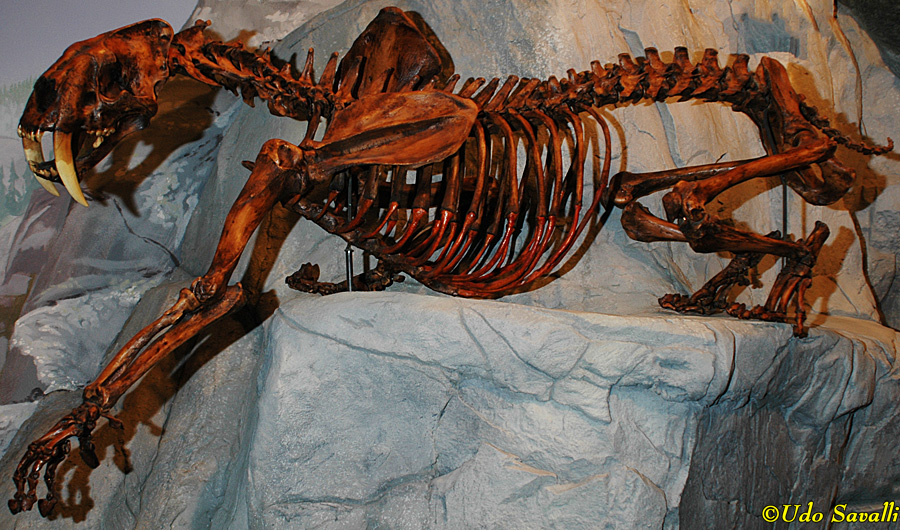
|
|
|
Xenosmilus hodsonae was fairly closely related to the sabertoothed cat Smilodon.
Order Carnivora
Florida
Pleistocene
Black Hills Institute Museum, South Dakota
|
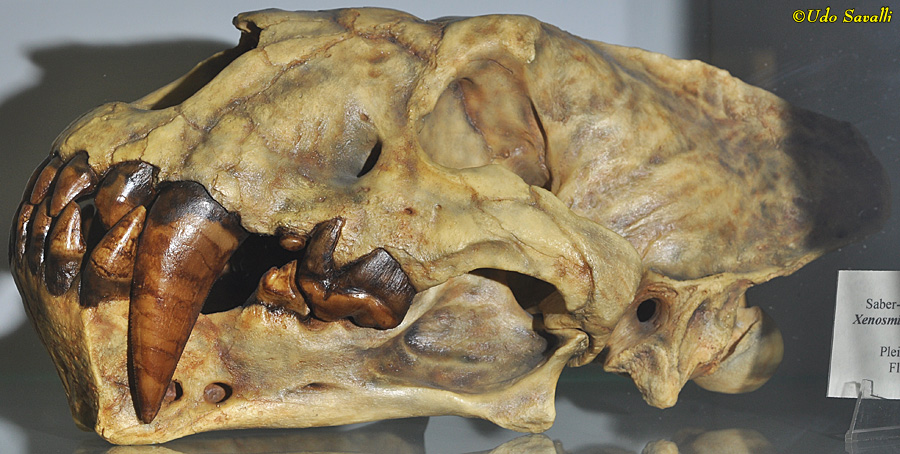
|
|
|
Amphimachairodus giganteus is another member of the sabertoothed cat group.
Order Carnivora
China
Miocene
Black Hills Institute Museum, South Dakota
|
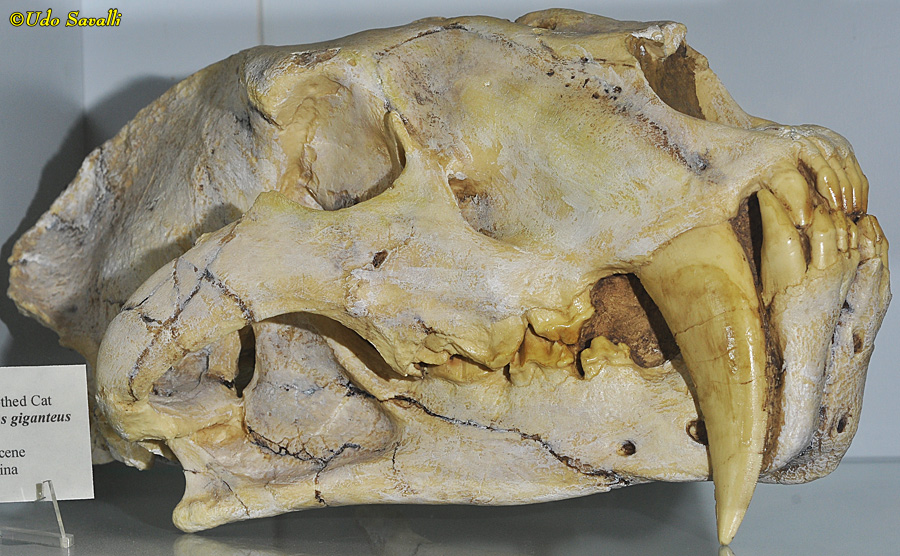
|
|
|
Nimravids are an extinct family of carnivores that are overall very cat-like. Some nimravids, such as this Hoplophoneus primaevus have convergently evolved larger saber-like canines.
Order Carnivora
River Formation; Wyoming
Oligocene
Wyoming Dinosaur Center
|
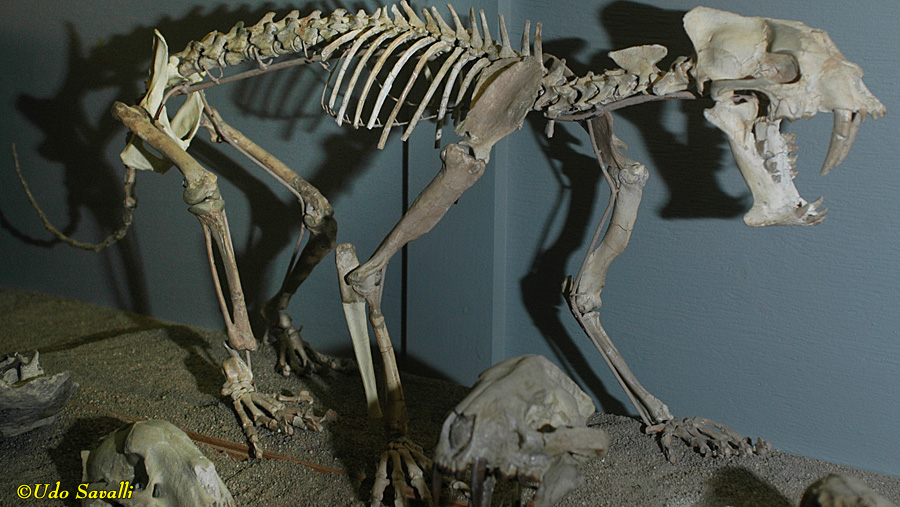
|
|
|
The nimravid, Dinictis sp.
Order Carnivora
White River Formation
Oligocene
Black Hills Institute Museum, South Dakota
|
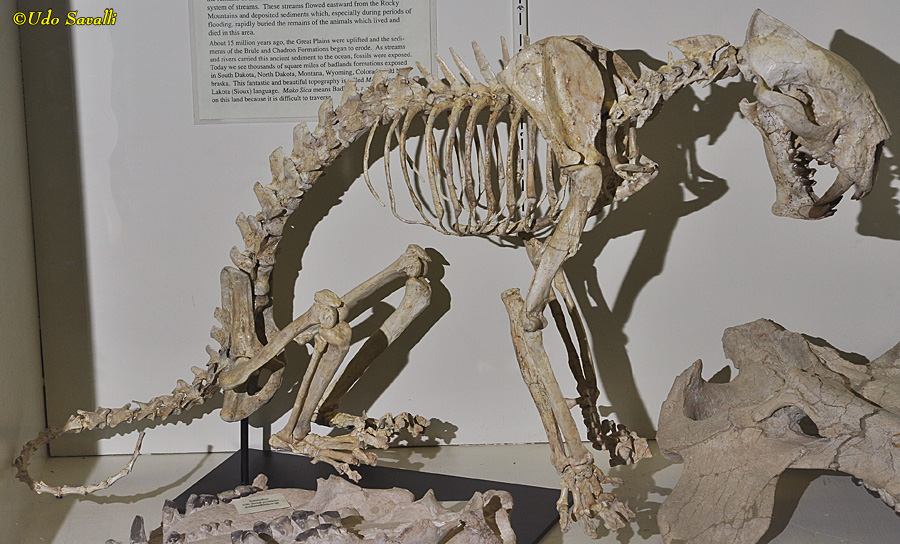
|
|
|
False sabertoothed cat, Eusmilus sqalidens (it is not a cat but a nimravid).
Order Carnivora
North America
Oligocene
Museum of Ancient Life, Utah
|
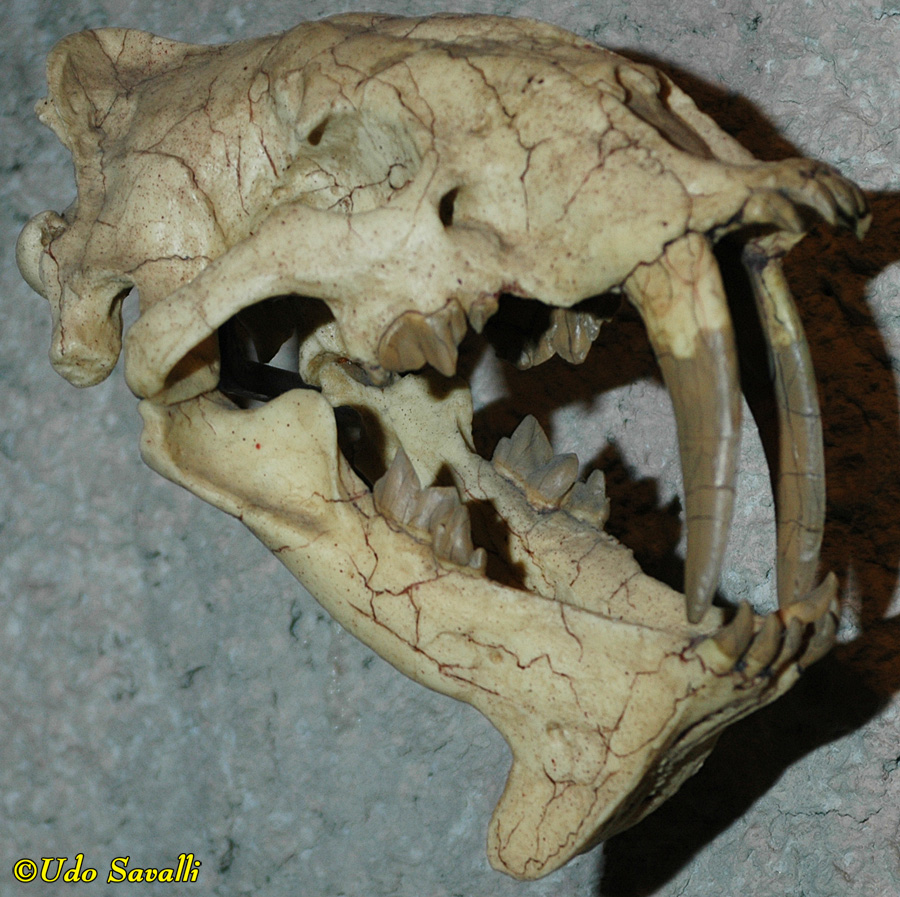
|
|
|
Pinnipeds, the seals and sea lions, are also members of the Order Carnivora, but they have evolved a mostly aquatic lifestyle. Allodesmus gracilis is an extinct pinniped that is neither seal nor sea lion.
Order Carnivora (Pinnipedia)
Sharktooth Hill, CA
Middle Miocene, 15 Ma
Los Angeles Museum of Natural History
|
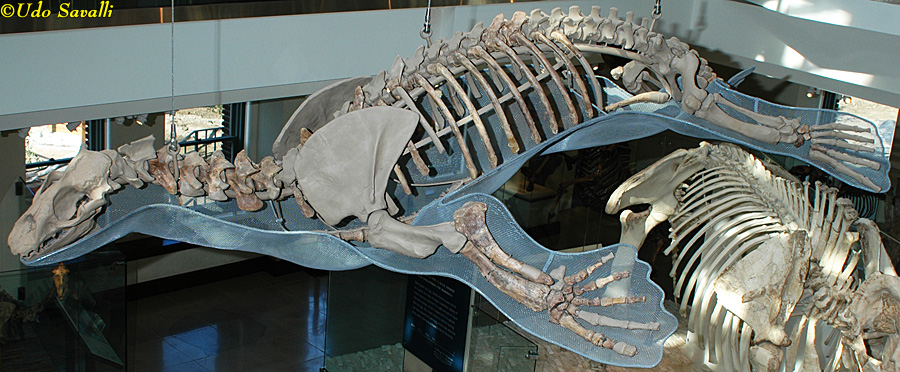
|
|
|
Chula Vista Walrus, Valenictus chulavistensis.
Order Carnivora (Pinnipedia)
San Diego Formation, California
Pliocene, 3.5 Ma
San Diego Natural History Museum
|
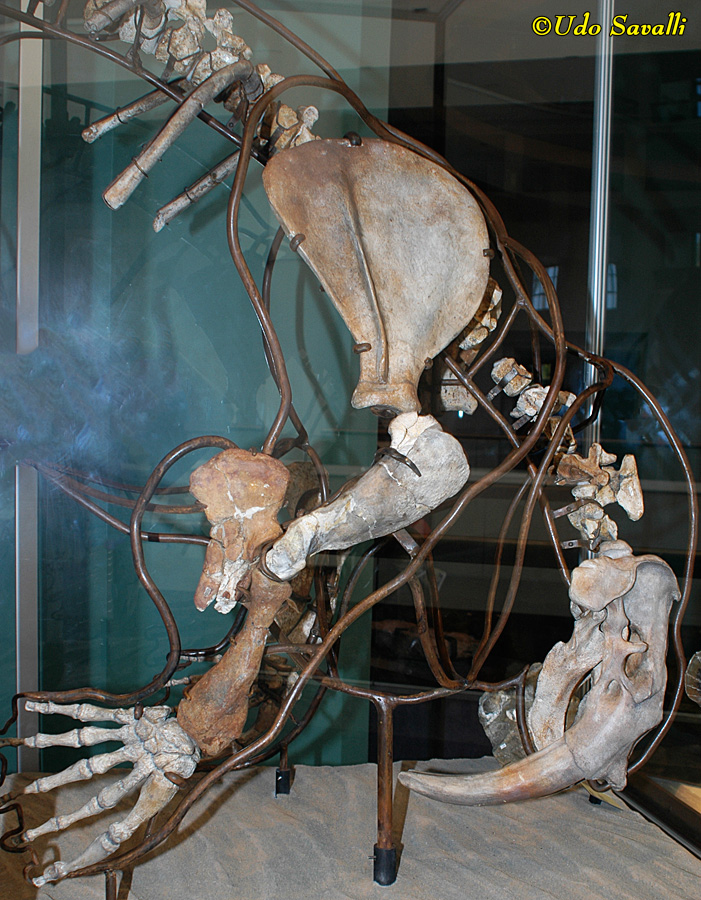
|
|
|















































